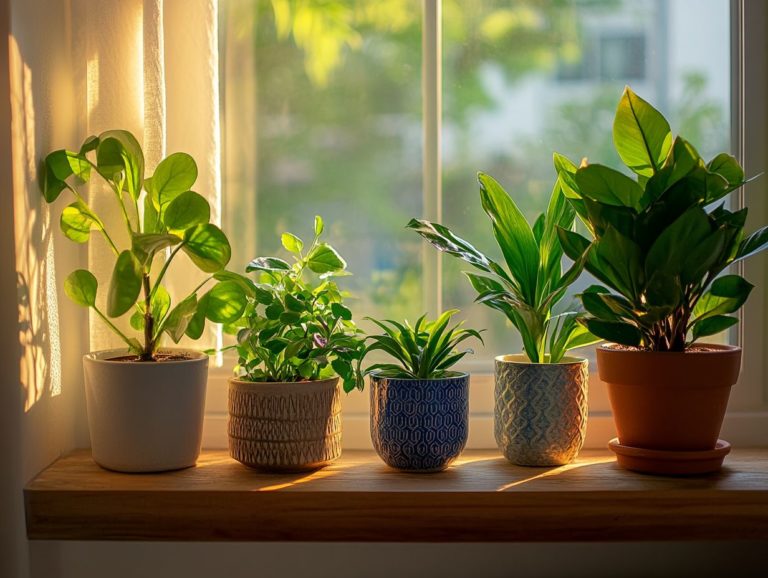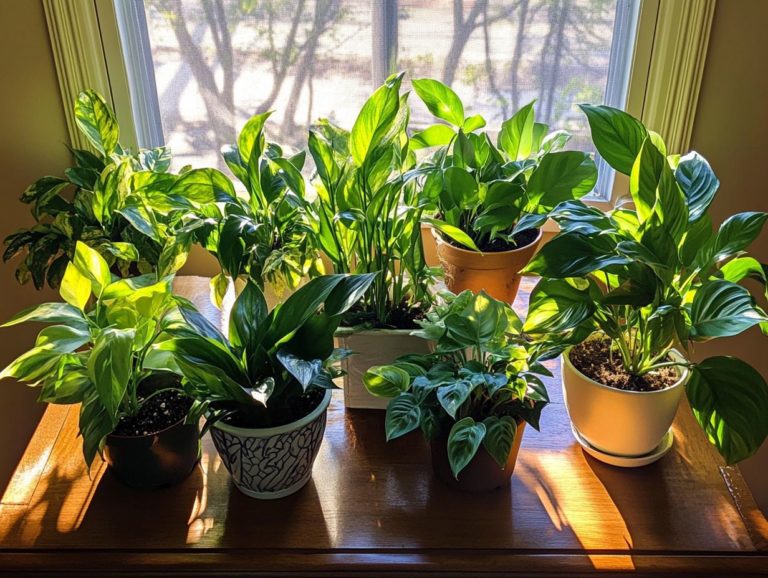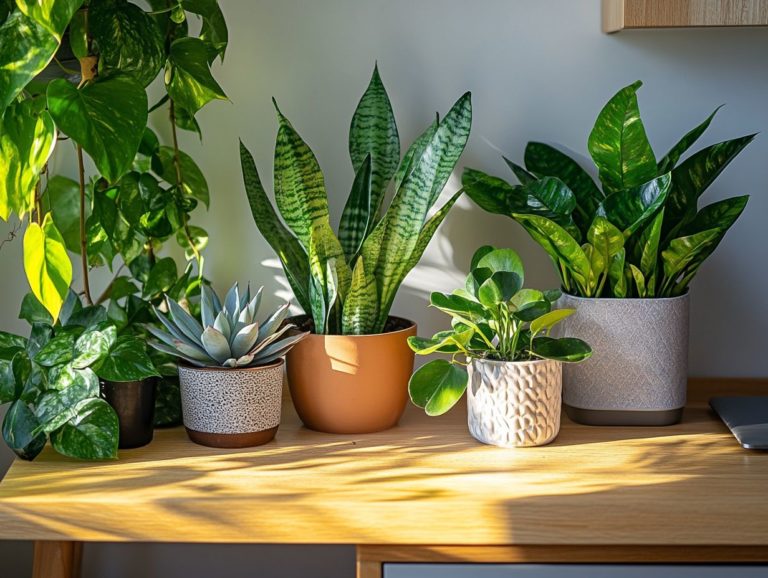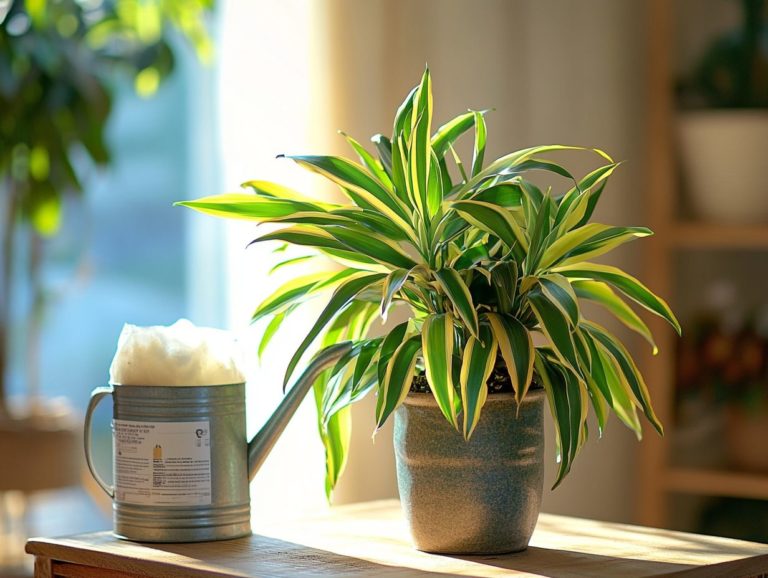10 Popular Indoor Succulents You Should Try
Are you eager to infuse a hint of greenery into your home without the burden of high-maintenance plants?
Succulents present an ideal solution! With their captivating shapes and vibrant hues, these resilient plants not only elevate your living space but also require minimal care.
This article delves into ten popular indoor succulents, offers essential tips for their care, and reveals the numerous benefits they bring to your home. Whether you re an experienced plant parent or just starting out, you ll find valuable insights tailored for everyone!
Contents
- Key Takeaways:
- 1. Aloe Vera
- 2. Echeveria
- 3. Jade Plant
- 4. Burro’s Tail
- 5. Zebra Plant
- 6. Haworthia
- 7. Panda Plant
- 8. String of Pearls
- 9. Christmas Cactus
- 10. Kalanchoe
- What Are Succulents and Why Are They Popular Indoor Plants?
- What Are the Different Types of Succulents?
- How to Care for Indoor Succulents?
- What Are the Benefits of Having Succulents in Your Home?
- What Are Some Common Mistakes When Caring for Indoor Succulents?
- Exciting Ways to Grow Your Succulent Collection!
- What Are Some Creative Ways to Display Succulents in Your Home?
- Can Succulents Be Kept Outdoors as Well?
- How Can You Tell If Your Succulent Is Healthy?
- What Are Some Other Low-Maintenance Indoor Plants Similar to Succulents?
- Frequently Asked Questions
Key Takeaways:

- Succulents are low-maintenance and thrive in various climates.
- Popular types include Aloe Vera and Echeveria, which add greenery with little care.
- To care for succulents, provide sunlight, well-draining soil, and only water when necessary.
1. Aloe Vera
Aloe Vera is an indoor succulent that stands out for its striking appearance and impressive health benefits, making it a beloved choice among plant enthusiasts and gardening novices alike. It thrives indoors with minimal care just bright light and well-draining soil making it perfect for your succulent collection or a fantastic first plant for those venturing into low-maintenance houseplants.
This versatile plant flourishes in bright, indirect sunlight but can handle a bit of direct rays, especially during the cooler months. Water lightly typically every two to three weeks letting the soil dry out completely between waterings to avoid root rot.
Be mindful of common pests like mealybugs and aphids; regular checks are key to keeping your Aloe in tip-top shape! Beyond its visual appeal, Aloe Vera is celebrated for its soothing gel, often a go-to remedy for burns and skin irritations, elevating it to the status of a household essential.
Its adaptability makes Aloe Vera a delightful addition to various succulent arrangements, harmonizing beautifully with different interior designs or garden landscapes.
2. Echeveria
Echeveria is a captivating genus of succulent plants, known for its striking rosette shape and vibrant hues! These beauties are a go-to choice for succulent enthusiasts and indoor gardeners alike. With various Echeveria types available, they thrive best in bright light and require a few specific care techniques to flourish indoors.
Caring for Echeveria involves balancing light exposure and water management. Avoid too much water, which can lead to root rot, while too little moisture may leave your plants looking shriveled. The ideal soil for these succulents is well-draining think cactus mix or a homemade blend featuring coarse sand and perlite for optimal aeration. Echeveria can be showcased in pots, rock gardens, or as part of larger succulent displays.
Standout varieties like Echeveria ‘Lola’ and ‘Rainbow’ are sure to catch your eye, boasting unique colors and shapes that make them perfect focal points in any collection. Their versatility allows for creative arrangements in terrariums or as striking table centerpieces, infusing a touch of modern greenery into your space.
3. Jade Plant
The Jade Plant, scientifically known as Crassula ovata, is your go-to indoor succulent. It adds a touch of elegance to your space and is regarded as a symbol of good luck and prosperity. This hardy gem boasts thick, oval leaves and can adapt to various environments. It thrives as long as it gets plenty of sunlight and well-draining soil.
Its growth is slow to moderate, making it a perfect fit for any indoor setting without demanding constant attention. Caring for this plant is easy! Just remember to water it regularly but do so sparingly to avoid root rot. Provide bright, indirect sunlight for optimal growth.
If you re eager to propagate, you ll be pleased to know it s as simple as taking a leaf cutting, allowing the cut edge to dry for a few days before planting, and placing it in soil to develop roots. Be cautious of the common trap of overwatering, which can spell trouble for your plant. By following these straightforward care tips, you’ll effortlessly enjoy the vibrant presence of this delightful plant in your home.
4. Burro’s Tail
Burro’s Tail, a captivating succulent from the Sedum family, features a unique trailing growth with plump, green leaves that resemble a donkey’s tail. It s a perfect addition to elevate your indoor succulent collection. This low-maintenance gem thrives in bright light. You’ll want to master the art of watering to prevent root rot while showcasing its decorative allure.
To create the ideal environment, use well-draining soil and select a pot with drainage holes. Positioning Burro’s Tail on a bright windowsill or in a spot that receives indirect sunlight encourages robust growth. Water only when the soil is completely dry typically every few weeks and steer clear of over-fertilizing, as this can lead to that dreaded leggy growth, which occurs when a plant becomes tall and spindly due to insufficient light.
Showcase this succulent in hanging baskets or wall-mounted planters for a stunning effect! Keep an eye out for pests like mealybugs and aphids they can harm your plant along with diseases such as powdery mildew, which could detract from its vitality.
5. Zebra Plant
The Zebra Plant, scientifically known as Haworthia, boasts striking white stripes along its lush green leaves. It is an exceptional and eye-catching choice among indoor succulents, particularly for those who prefer low-maintenance options. This resilient plant flourishes in bright light and requires minimal attention while infusing your home with a touch of exotic elegance.
To keep your Zebra Plant thriving, a consistent watering routine is essential, typically every two to three weeks. It thrives in well-draining soil, which you can easily achieve by mixing cactus soil with perlite. This combination prevents root rot and promotes optimal air circulation.
For indoor gardening enthusiasts, incorporating the Zebra Plant into a broader succulent display can result in a visually stunning arrangement. Pair it with complementary varieties that have similar light and water requirements. This enhances the overall aesthetics while creating a harmonious environment that nurtures all your plants effectively.
6. Haworthia
Haworthia is a remarkable collection of succulent plants celebrated for their stunning rosettes and captivating leaf patterns. They are a top pick for indoor succulent aficionados like you. These resilient plants flourish in various habitats and boast low maintenance needs. They thrive with just a bit of TLC, elevating your gardening collection.
Within the Haworthia genus, you ll discover many species, each showcasing unique traits that cater to different aesthetic tastes. Take Haworthia attenuata, for instance its striking white tubercles make it a favorite for those who appreciate eye-catching plants. Meanwhile, Haworthia zebra dazzles with its bold, zebra-like stripes.
Caring for these beauties is straightforward. They prefer bright, indirect light and well-draining soil to keep root rot at bay. A minimalist watering routine suits them best just allow the soil to dry out completely between waterings for optimal health.
One common mistake to watch out for is overexposure to direct sunlight, which can lead to unsightly leaf burn. By understanding their specific needs and fine-tuning their environment, you can ensure that these stunning plants thrive beautifully in your indoor space.
7. Panda Plant
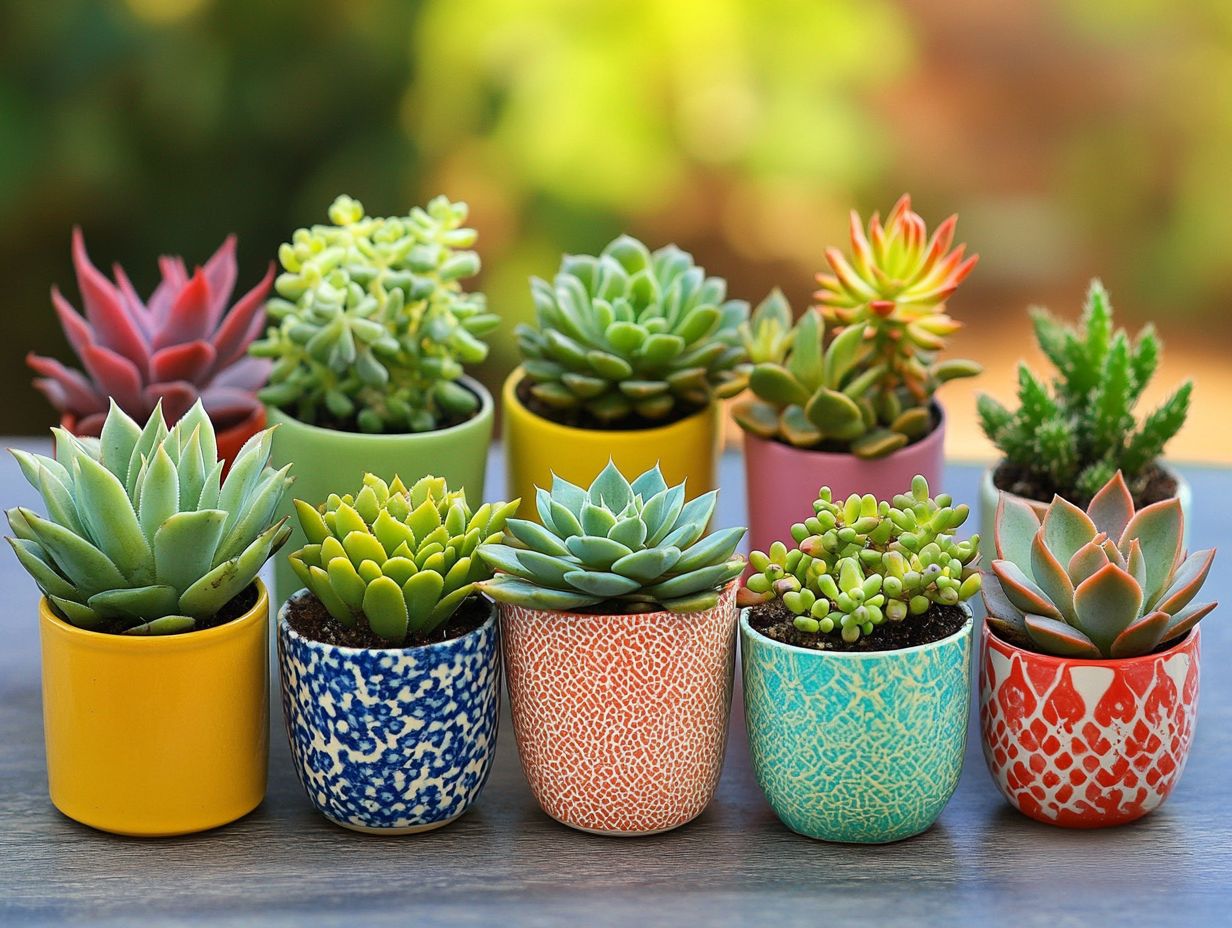
The Panda Plant, with its irresistibly fuzzy leaves that mimic the ears of a panda, is a delightful addition to your indoor succulent collection. It offers both aesthetic charm and the luxury of low maintenance. This unique succulent variety thrives in bright light, adding a fun touch to your home.
To ensure it grows optimally, you ll want to use well-draining soil, such as a cactus mix or a blend of potting soil and sand, which helps to prevent root rot. Watering should be done carefully; allow the soil to dry out completely between waterings to mimic its natural arid habitat.
Its light preferences lean toward bright, indirect sunlight, making it suitable for various spots throughout your home.
With its charming appearance, it’s no surprise that plant lovers love to show off this succulent in quirky pots or terrariums, elevating the interior ambiance with its delightful presence.
8. String of Pearls
String of Pearls is a captivating succulent that boasts bead-like leaves cascading elegantly, making it an exquisite choice for your hanging arrangements in indoor gardening. Its unique appearance not only elevates your home decor but also brings some care challenges, particularly regarding watering and soil preferences.
To thrive, this plant craves well-draining soil and bright, indirect light. Be cautious with watering; overdoing it can lead to root rot, so ensure the soil dries out between waterings.
Regarding care, you ll want to nourish it with a diluted succulent fertilizer during the growing season. You ll be amazed at how easy it is to propagate this stunning plant! Simply pinch off a section of the vine and place it in soil to encourage root growth.
When showcasing your String of Pearls, think about using a macram hanger or a simple shelf arrangement to highlight its beautiful cascading nature, creating a stunning visual effect that will undoubtedly impress.
9. Christmas Cactus
The Christmas Cactus is a remarkable succulent that truly shines with its vibrant blooms during the winter months, making it an exquisite addition to your indoor garden. Unlike your average succulent, it has specific care needs that demand well-draining soil and thoughtful watering techniques to truly thrive indoors. This is essential knowledge for any plant parent looking to expand their succulent collection.
This captivating plant requires a careful balance of hydration; overwatering can lead to root rot, while too little moisture can stifle its growth. Watering should occur when the top inch of soil feels dry, ensuring the roots receive just the right amount of sustenance without being waterlogged.
Regarding light, the Christmas Cactus prefers bright, indirect sunlight, as direct exposure can scorch its delicate leaves.
To encourage those breathtaking seasonal blooms, consider reducing watering slightly and placing the plant in cooler temperatures during the fall. This simulates its natural dormant period and sets the stage for a vibrant display of flowers come winter.
10. Kalanchoe
Kalanchoe is a vibrant genus of succulents. Known for their colorful blooms and resilient nature, these plants are a favorite among indoor gardening enthusiasts.
With various types of Kalanchoe available, they thrive in bright light. They also adapt well to different growing conditions, enhancing your indoor succulent collection.
Take, for instance, the striking Kalanchoe blossfeldiana, which dazzles with clusters of flowers in many hues. The delicate Kalanchoe panda plant has fuzzy leaves that add unique charm to your decor.
Proper care is crucial for these succulents. They thrive in well-draining soil but can suffer from overwatering and pests.
Display these lovely plants in decorative pots on windowsills or as stylish table centerpieces. Combine thoughtful care practices with mindful placement to enjoy their resilience and beauty.
What Are Succulents and Why Are They Popular Indoor Plants?
Succulents are unique plants known for their thick, fleshy tissues that store water. This ability allows them to thrive indoors with minimal care, making them highly desirable for your indoor gardening efforts.
Their low-maintenance nature and diverse aesthetic variations contribute to their rising popularity among plant enthusiasts and casual gardeners. Some you might consider include the jade plant, aloe vera, and snake plant.
Succulents have fascinating adaptations from their evolution in dry environments. They developed special structures to conserve moisture and endure droughts.
This resilience enables succulents to flourish in homes worldwide. With diverse shapes and colors, they enhance both small and large spaces.
Growing succulents offers more than just beauty; they improve indoor air quality and create a calming atmosphere, making them the perfect choice for modern living.
What Are the Different Types of Succulents?
Explore the world of succulents! You’ll find a stunning variety, each with unique colors and shapes.
From the rosette-shaped Echeveria to the trailing String of Pearls, there’s a succulent for every taste and style.
These enchanting plants thrive in many conditions, making them perfect for both seasoned gardeners and beginners.
Some varieties, like the hardy Sedum, are tough. Others, such as the delicate Haworthia, need a bit more care regarding light and water.
By mixing different specimens, you can create a beautiful display. Arrange them in decorative pots or terrariums to bring nature indoors and enhance your space.
How to Care for Indoor Succulents?
Caring for indoor succulents means understanding their needs. Pay attention to watering, light, and soil types.
Most succulents love bright light and need well-draining soil, which is soil that lets water flow out easily.
To keep your succulents healthy, adjust your watering based on humidity and temperature. Overwatering can cause root rot, so be careful!
Let the soil dry out between watering sessions. Proper light exposure is also key; most succulents thrive in direct sunlight for several hours a day.
When building your collection, choose different types that complement each other. This will create a vibrant display that flourishes beautifully indoors!
What Are the Benefits of Having Succulents in Your Home?
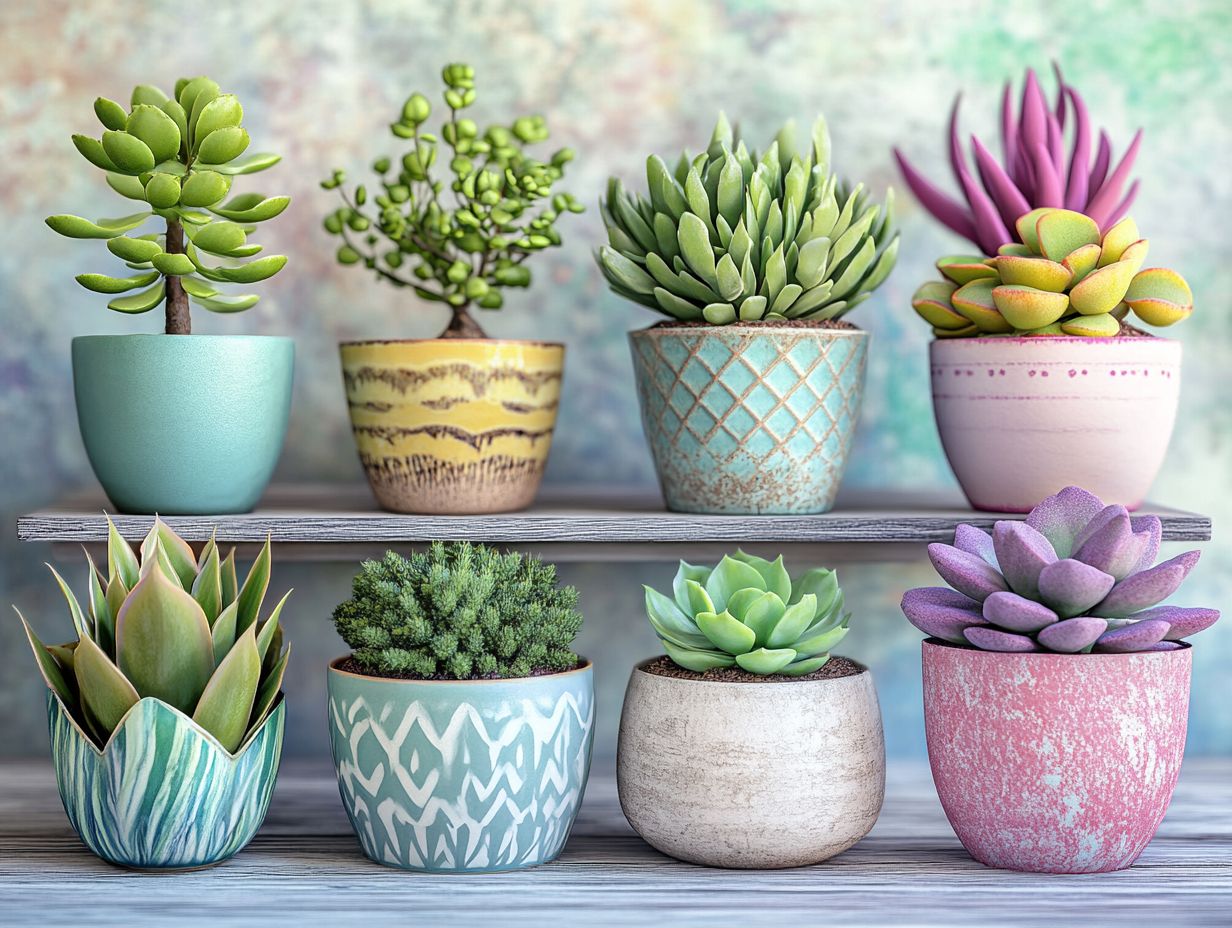
Having succulents in your home brings a wealth of benefits. They enhance the aesthetic charm of your living space while also improving air quality and fostering a sense of well-being. These resilient indoor plants thrive on minimal care, making them an ideal choice for your busy lifestyle.
With succulents, you can revel in the beauty of gardening without extensive effort. By selecting the best indoor varieties, such as those listed in the top 10 indoor plants for artificial light, you can maximize their benefits. Not only do they purify the air by absorbing carbon dioxide and releasing oxygen, but their vibrant hues and unique shapes can elevate any room’s decor.
To effectively incorporate succulents into your living spaces, consider arranging them in decorative pots on windowsills, coffee tables, or even hanging them to create eye-catching vertical gardens.
This approach adds a refreshing touch while serving as a natural stress reliever. It offers a calming effect that enhances both productivity and relaxation.
Whether you group them together or display them as individual pieces, succulents can transform into stunning focal points in your home.
What Are Some Common Mistakes When Caring for Indoor Succulents?
Many new plant parents often stumble into common pitfalls with indoor succulents, leading to unhealthy plants or even complete plant loss. Understanding these mistakes like overwatering, insufficient light, and poor soil choices is key to keeping your plants thriving.
One crucial aspect to consider is the different types of indoor plants that need special care. By honing in on these factors, you can cultivate thriving plants that brighten your living spaces and provide a gratifying sense of achievement.
A major oversight to avoid is neglecting adequate drainage, which can trap water and lead to root rot. Incorporating well-draining soil and selecting pots with drainage holes can significantly reduce this risk.
Understanding the specific sunlight requirements of your succulents will also help you provide the right amount of natural light. This prevents that dreaded leggy growth. With these straightforward practices, you can elevate the health of your cherished succulents and watch them flourish.
Exciting Ways to Grow Your Succulent Collection!
Propagating succulents is a truly rewarding endeavor that allows you to expand your collection of these stunning indoor plants. Transform a single succulent into a thriving array of specimens! Get ready to discover fun ways to grow new plants!
This process involves various techniques tailored to the specific succulent varieties you have on hand, whether it s leaf cuttings, offsets, or stem cuttings. Each technique offers its own unique route to enhance your gardening journey.
To kick things off, consider using leaf cuttings for popular varieties like Echeveria and Jade plants. Just twist off a healthy leaf and let it dry for a few days to form a callous.
Next, place it on soil. If your succulent has offsets, or pups, gently separate them from the parent plant and replant them. For taller succulents, stem cuttings work wonders: simply cut a healthy stem and allow it to dry.
Once you ve propagated your new plants, ensure they receive adequate bright light while avoiding direct sunlight. Keep the soil slightly moist until roots begin to form. With the right care requirements, your new additions will flourish beautifully!
What Are Some Creative Ways to Display Succulents in Your Home?
Displaying succulents creatively in your home can truly elevate your spaces into vibrant, living decor elements that reflect your unique style. Whether you opt for terrariums, hanging planters, wall art, or one-of-a-kind containers, the possibilities for showcasing these indoor gems are limitless.
To maximize their impact, think about selecting materials that complement your existing decor. Rustic wooden boxes can evoke a cozy farmhouse feel, while sleek ceramic pots perfectly fit a contemporary vibe.
You might also consider incorporating elements like driftwood or colored stones to enrich the overall arrangement. Don t hesitate to play with heights by layering containers of different sizes.
This not only creates visual intrigue but also allows you to express your creativity. Grouping clusters of succulents can serve as a stunning focal point, beautifully showcasing nature s charm while harmonizing seamlessly with your interior s color palette and theme.
Can Succulents Be Kept Outdoors as Well?
While you may often cherish indoor succulents as indoor companions, many varieties can thrive beautifully outdoors. This enhances the charm and versatility of your gardens and patios.
Understanding the specific needs of each succulent type is essential for ensuring they adapt seamlessly to outdoor conditions. Allow them to bask in sunlight while flourishing in well-draining soil.
Certain varieties, like agaves, sedums, and aeoniums, are particularly resilient and can handle outdoor exposure. To help them thrive, provide adequate drainage and minimize water retention.
Excess moisture can lead to rot. Planting succulents in the right conditions enhances their growth. During extreme weather conditions be it frost or intense heat protective measures like row covers or shade cloth can offer the necessary safeguard for these plants.
When integrating succulents into your outdoor setting, consider grouping various types of succulents based on their growth habits and colors. This approach creates a dynamic visual impact while allowing each plant s unique characteristics to truly shine.
Start propagating your succulents today and share your experiences! Join the conversation and foster a vibrant community of succulent enthusiasts.
How Can You Tell If Your Succulent Is Healthy?
To identify healthy succulents, look for signs like vibrant colors, firm leaves, and robust growth. These traits are crucial for maintaining a thriving indoor garden.
Check for plump, fleshy leaves, which indicate that your plant is getting enough water. Rich colors are a good sign; browning or dullness may suggest overexposure to sunlight or not enough watering.
Pay attention to growth patterns. Stunted growth can mean your plant is lacking nutrients or is in poor soil.
Common issues with succulents often come from pests or plant diseases. Regularly inspect your plants for any signs of damage.
Taking care of your plants early, like using soil that drains well and providing the right amount of sunlight, can significantly enhance their health.
What Are Some Other Low-Maintenance Indoor Plants Similar to Succulents?
If you love the low-maintenance nature of succulents, you’ll find many indoor plants that are just as easy to care for. Plants like snake plants and pothos thrive indoors and need minimal upkeep.
These options are ideal for busy individuals or those new to indoor gardening. They tolerate various light levels and only need infrequent watering.
Snake plants have striking upright leaves and purify the air, making them a beautiful focal point in any room. Pothos adds a lush touch with its cascading vines, perfect for enhancing shelves or walls.
Consider adding Crassula or Kalanchoe for even more diversity in your plant collection.
Incorporating these plants into your home refreshes your space and contributes to a healthier indoor environment. Their resilience makes them suitable for both gardening enthusiasts and novices alike.
Frequently Asked Questions
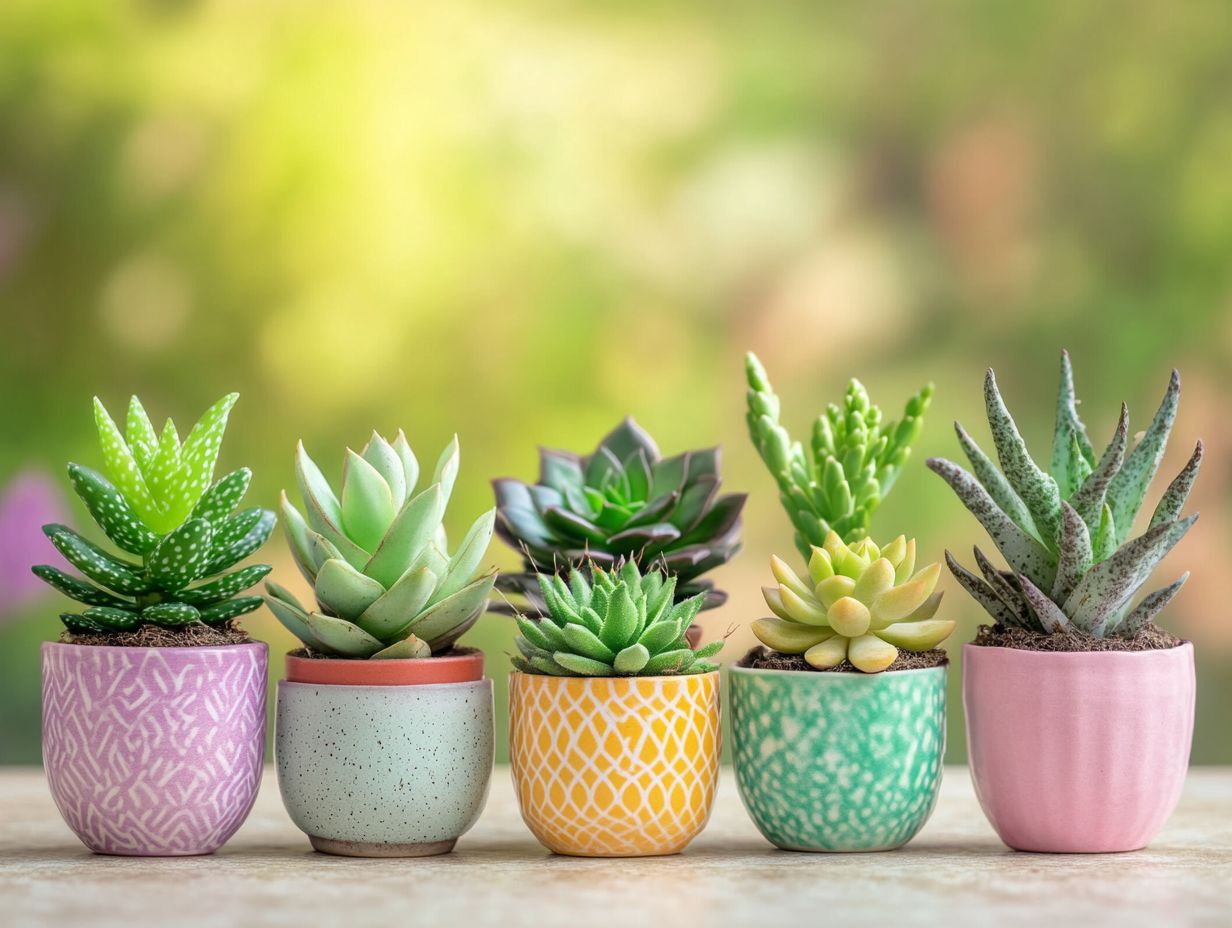
1. What are some popular indoor succulents I should try?
Some popular succulents include Aloe Vera, Jade Plant, Echeveria, and String of Pearls.
2. Can succulents thrive indoors?
Yes, many succulents thrive indoors with plenty of sunlight and proper care.
3. How often should I water my indoor succulents?
This depends on the type of succulent and its environment. Generally, water them about once a week.
4. Which succulents are low maintenance for indoor spaces?
Low-maintenance succulents include Zebra Plant, Haworthia, and Crown of Thorns.
5. What are some good succulents for beginners?
Good succulents for beginners are Snake Plant, Pincushion Cactus, and Panda Plant. You might also consider the African milk tree or cactus for variety.
6. Do indoor succulents need fertilizer?
It’s not necessary, but you can use a diluted succulent-specific fertilizer once a month during the growing season to promote healthy growth.

